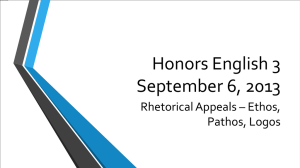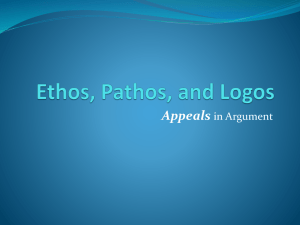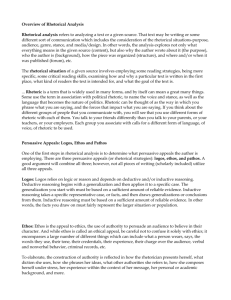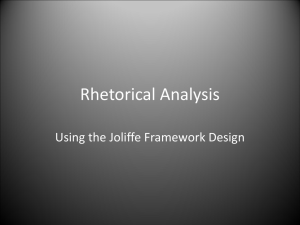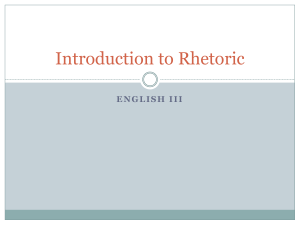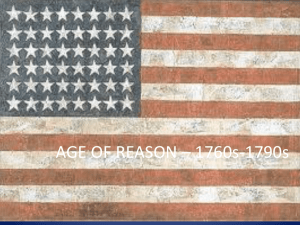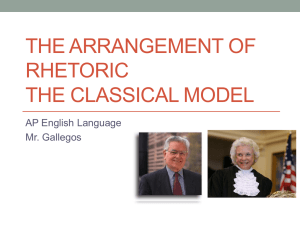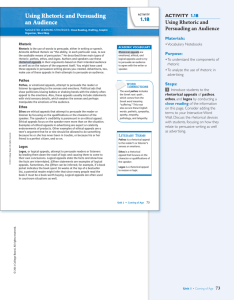A General Summary of Aristotle`s Appeals
advertisement
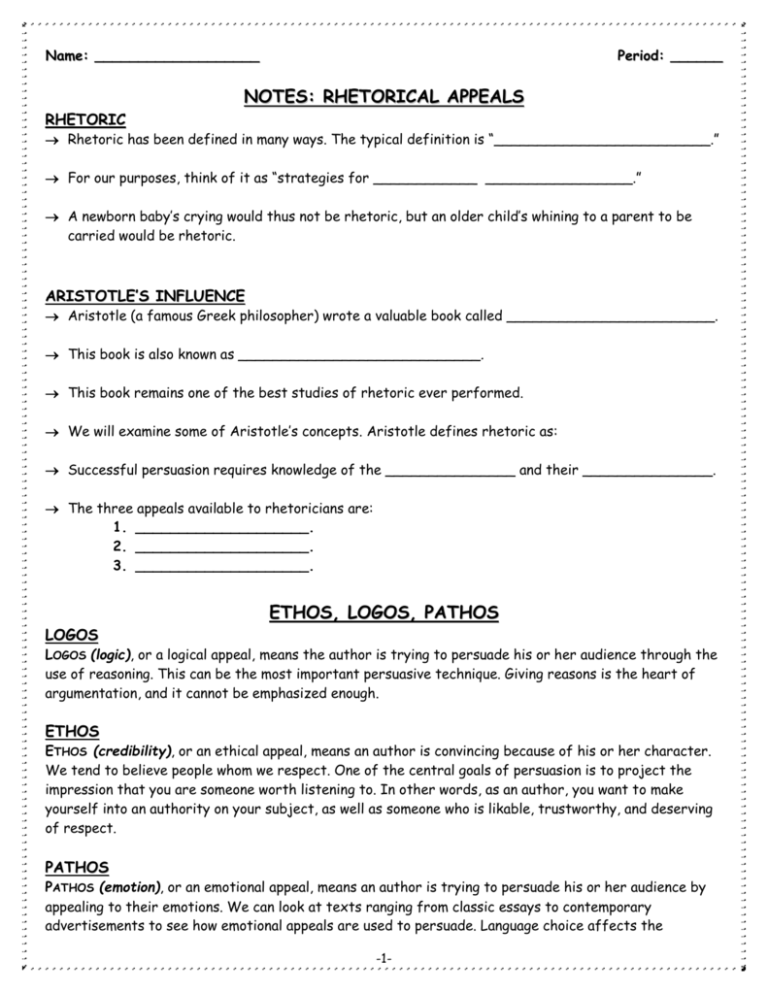
Name: ___________________ RHETORIC Period: ______ NOTES: RHETORICAL APPEALS Rhetoric has been defined in many ways. The typical definition is “_________________________.” For our purposes, think of it as “strategies for ____________ _________________.” A newborn baby’s crying would thus not be rhetoric, but an older child’s whining to a parent to be carried would be rhetoric. ARISTOTLE’S INFLUENCE Aristotle (a famous Greek philosopher) wrote a valuable book called ________________________. This book is also known as ____________________________. This book remains one of the best studies of rhetoric ever performed. We will examine some of Aristotle’s concepts. Aristotle defines rhetoric as: Successful persuasion requires knowledge of the _______________ and their _______________. The three appeals available to rhetoricians are: 1. ____________________. 2. ____________________. 3. ____________________. LOGOS ETHOS, LOGOS, PATHOS LOGOS (logic), or a logical appeal, means the author is trying to persuade his or her audience through the use of reasoning. This can be the most important persuasive technique. Giving reasons is the heart of argumentation, and it cannot be emphasized enough. ETHOS ETHOS (credibility), or an ethical appeal, means an author is convincing because of his or her character. We tend to believe people whom we respect. One of the central goals of persuasion is to project the impression that you are someone worth listening to. In other words, as an author, you want to make yourself into an authority on your subject, as well as someone who is likable, trustworthy, and deserving of respect. PATHOS PATHOS (emotion), or an emotional appeal, means an author is trying to persuade his or her audience by appealing to their emotions. We can look at texts ranging from classic essays to contemporary advertisements to see how emotional appeals are used to persuade. Language choice affects the -1- audience's emotional response. Consequently, emotional appeals use loaded language to enhance an argument effectively. MAKING CONNECTIONS TO ADVERTISING TECHNIQUES Bandwagon: intends to make the target audience feel left out Associated rhetorical appeals: Avant-garde: intends to make the target audience feel “hip” Associated rhetorical appeals: Testimonials: uses a specific spokesperson to endorse product Associated rhetorical appeals: Facts and Figures: statistics, percentages, and numbers Associated rhetorical appeals: Transfer: associates good feelings with the product Associated rhetorical appeals: LOGICAL APPEALS (LOGOS) Theoretical, abstract language Denotative meanings/reasons Literal and historical analogies Definitions Factual data and statistics Quotations Citations from experts and authorities Informed opinions ETHICAL APPEALS (ETHOS) Language appropriate to audience and subject Restrained, sincere, fair minded presentation Appropriate vocabulary Correct grammar Presents balanced views. Establishes credibility as narrator. EMOTIONAL APPEALS (PATHOS) Vivid, concrete language Emotionally loaded language Connotative meanings Emotional examples Vivid descriptions Narratives of emotional events Emotional tone Figurative language EFFECTS Evokes a cognitive, rationale response Demonstrates author's reliability, competence, and respect for the audience's ideas and values through reliable and appropriate use of support and general accuracy Evokes an emotional response EXAMPLES “The fashion industry has drawn “I think it’s outrageous; they “Eating disorders have the highest criticism for hyping the super-thin want to set this tone of healthy, mortality rate or any mental look, which critics say promotes beautiful women, but what about illness.” eating disorders among women.” discrimination…[and] freedom…” -2- -3-

